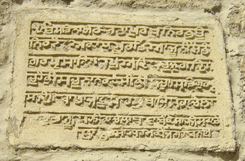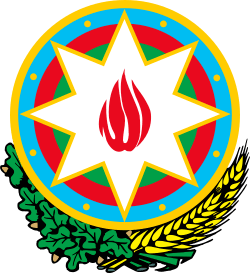Tourism in Azerbaijan
Azerbaijan occupies the 39th place[1] among 148 countries on competitiveness indicators in the field of tourism in the world. On the account of having rich oil resources, the country itself contributes to the amplification of the worldwide economy.
According to the report prepared by the World Travel and Tourism Council, Azerbaijan is among top ten countries which saw the strongest growth in visitor exports in 2010–2016. Also, Azerbaijan placed at the first place (46.1%) among the fastest developing travel and tourism economies and buoyed by strong in bound international visitor spending last year.[2][3]
Visa
Visa policy
Tourist visas can be obtained from Azerbaijani embassies around the world or through electronic visa online without going to any embassy. In 2016 a new tax-free shopping system was introduced in order to attract foreign shoppers. Purchases must be made up to three months (90 days) prior to export of the goods to be eligible for the tax refund.
Electronic visa
In January 2017 Azerbaijan introduced a new electronic visa that enables a single-entry visit up to 30 days.[4] The system is called ASAN Visa[5] and tourists from 93 countries can get an electronic visa by applying to the official website.[6] The electronic visa issued within 3 working days and the state fee is 20 USD. Urgent electronic visa also can be obtained in three hours regardless of non-working days and holidays.[7]
Visa is not required for citizens of CIS (except Turkmenistan and Armenia), who aim to visit the country within 90 days.
In November 2017, Committee of Labor and Social Policy had a special session. Members of the Committee suggested to edit 4@th point of an article numbered 7.1 and named "About tourism". Due to suggestions, words "travel agencies" were replaced by "ASAN VIZA system".[8]
Arrivals by country
The number of tourists who visited Azerbaijan in 2008 was more than 1.400.000. Most visitors arriving to Azerbaijan in 2016 were from the following countries of nationality:[9]
| Rank | Country | Number |
|---|---|---|
| 1 | 744,125 | |
| 2 | 506,306 | |
| 3 | 313,341 | |
| 4 | 248,632 | |
| 5 | 62,983 | |
| 6 | 55,508 | |
| 7 | 53,180 | |
| 8 | 31,994 | |
| 9 | 29,514 | |
| 10 | 16,093 | |
| 11 | 13,042 | |
| 12 | 12,320 | |
| 13 | 12,291 | |
| 14 | 10,814 | |
| 15 | 8,654 | |
| 16 | 7,637 | |
| 17 | 7,463 | |
| 18 | 7,363 | |
| 19 | 6,012 | |
| 20 | 5,785 | |
| Total visitors | 2,248,773 | |
| Year | The number of tourists | |
| 1 | 2006 | 900.000 |
| 2 | 2007 | 1.100.000 |
| 3 | 2008 | 1.400.000 |
| 4 | 2009 (9 months) | 1.000.988 |
| 5 | 2010 | 1.850.000 |
| 6 | 2011 | 2.239.000 |
| 7. | 2012 | 2.484.048 |
| 8. | 2013 | 2.508.904 |
| 9. | 2014 | 2.297.804 |
| 10. | 2015 | 2.006.176 |
| 11. | 2016 | 2.242.783 |
The majority of visitors were from Europe, Asia, North America.
There were 1.818.258 foreigners in Azerbaijan in 2017.[10] The overwhelming majority of them were citizens of Russian Federation, Arabic countries, Republic of Iran and Kazakhstan. The rest of the guests came from Eastern Europe (mostly Belarus and Ukraine) and Western Europe.[11]
Currently, there are 230 tourist agencies, 560 hotels and hostels.[12]
| Year | The number of hotels | |
| 1. | 2007 | 320 |
| 2. | 2008 | 370 |
| 3. | 2009 | 452 |
| 4. | 2010 | 499 |
| 5. | 2011 | 508 |
| 6. | 2012 | 514 |
State support
Beginning from 2002, there were several programs compiled by the state. For instance, "Tourism development planning within 2002–2005 and 2010–2014 years".[1] The program set a goal which denoted to compile statistics of tourism, especially, an annual income level of GNP. The second one was compiled by Ministry of Tourism and named "The development of tourism in Azerbaijan during 2008–2016".[13] The program contained plans like an organization of training in tourism, an increase in the number of accommodation and etc. in order to attract foreigners.
In March 2018, the chief of the Department of tourism in Ministry of culture and tourism – Aydin Ismiyev declared about his desire to found "Halal tourism"[14] (azərb. "Halal turizm"). The uppermost aim of this project is to provide visitors, notably, from Muslim East with brand new tourism standards, because "Halal tourism" is considered as a new direction in tourism. According to the project, authorities plan to upsurge the number of hotels and hostels.
In April 2018, an international exhibition "Tourism and Travel" (AITF 2018) was opened. The exhibition is the 17-th by number.[15]
Nowadays, economy of Azerbaijan experiences an evolvement of one of the most widespread kinds of tourism – gastronomical tourism.[16] Besides this, there are other types of tourism such as sports, ecological, hunting, informative, piscatorial, business, therapeutic and etc.
Resort areas
Besides the capital – Baku, there are more than 10 resort areas in Azerbaijan. The variety of climatic conditions and flora and fauna causes a huge flow of tourists. The most remarkable resort areas are located in such cities as Ganja, Nakhchivan, Gabala and Shaki[17]
In Ganja, visitors are offered excursion tourism which means to look at unique architecture (particularly, karavan-sarays) and shopping centers in the city.[18]
Shaki is famous for its architectural heritage – Shaki khans Palace[19](1763). Moreover, there are many mausoleums, fortresses and religious institutions.
Historical methods of treatment using traditional medicine skills date back to ancient times. This caused a transformation of Nakhchivan into a centre of health care tourism indicated by salt mines in Duzdagh (1173 meters). Tourists are also interested in mausoleums. The town itself was established 3500 years ago.
Among old cities of Azerbaijan, noteworthy is Lankaran whose history starts from the 10th century BC. It's located near the Caspian Sea and is also known as a resort area with health care tourism advantages.[17]
Historical monuments
Walled City of Baku with the Shirvanshah's Palace and Maiden Tower

The capital city of Baku has numerous historical and architectural monuments dating to various historical epochs.
The Walled City of Baku is the ancient historical core of Baku. In December 2000, the Old City of Baku, including the Palace of the Shirvanshahs and Maiden Tower, became the first location in Azerbaijan to be classified as a World Heritage Site by UNESCO.
The Walled City of Baku or Icheri Sheher hosts over 50 historical and architectural monuments from various eras. The Palace of the Shirvanshahs, the Maiden Tower and Synyg Gala (the Broken Tower) are among the monuments which survived until present day. The Palace of Shirvanshahs is one of the pearls of Azerbaijani architecture. It was built in the beginning of the 15th century. It includes a historical complex, the palace, a divankhana, the Shirvanshah's room, a palace mosque with minarets, bath house, a room of Seyid Yahya Bakuvi, and the Western divankhana monuments, which were built during a later stage. The complex construction began in 1441, while the Western divankhana was completed by architect Amirshah in 1558.
Azerbaijan's architectural monument the Maiden Tower is located in the south-western part of the Walled City of Baku or Icheri Sheher. The tower was built in two stages. Its bottom part with a height of 13.7 meters is dated by most experts to the 6th–7th centuries BC. The Maiden Tower has a total height of 29.7 meters, with a diameter of 16.5 meters. The wall thickness in the bottom part is 5 meters, reducing to 4 meters at the top. The tower consists of eight tiers and has a 21-meter-deep water well. It was built by the 12th-century architect Masud ibn Davud, who was probably the father of the architect of Mardakan Round Tower (not to confuse with Mardakan castle).[20] Its foundation are believed to be a Sasanid era Zoroastrian site.[21]
Ateshgah of Baku
Another historical sight in Baku is the Ateshgah temple, situated in south-western part of the Surakhani settlement in the Absheron peninsula, 30 km away from Baku. Ateshgah is a fire temple, built in the 17th–18th centuries. The temple's central stone shrine is located on a natural gas pocket. The present structure was built approximately in 1713 AD, and the building of the central stone shrine was funded by merchant Kanchanagaran in 1810.
The Absheron peninsula is famous for oil oozing out of the ground naturally, as well as for natural oil fires.[22] Zoroastrianism has a long history in Azerbaijan and the lands of Absheron were held to be sacred by Zoroastrians due to these natural fires.[22]
Some scholars have speculated that the Ateshgah may have been an ancient Zoroastrian shrine that was decimated by invading Islamic armies during the Muslim conquest of Persia and its neighboring regions.[23]
The complex was turned into a museum in 1975 and now receives about 15,000 visitors a year. It was nominated for World Heritage Site status in 1998 and was declared a state historical-architectural reserve.
Gobustan Rock Art Cultural Landscape
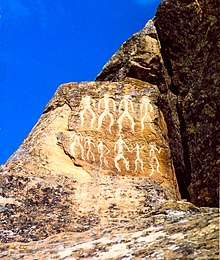
One of the most ancient monuments of Baku is Gobustan, famous around the world for its rock carvings. Gobustan Rock Art Cultural Landscape was established in 1966 when the region was declared as a national historical landmark of Azerbaijan in an attempt to preserve the ancient carvings, mud volcanoes and gas-stones in the region.
The reserve of Gobustan has more than 6,000 rock engravings dating back between 5,000 and 40,000 years. The site also features the remains of inhabited caves, settlements and burials, all reflecting an intensive human use by the inhabitants of the area during the wet period that followed the last Ice Age, from the Upper Paleolithic to the Middle Ages. The site, which covers an area of 537 ha, is part of the larger protected Gobustan Reservation.[24]
Most of the rock engravings depict primitive men, animals, battle-pieces, ritual dances, bullfights, boats with armed oarsmen, warriors with lances in their hands, camel caravans, pictures of sun and stars.[25]
In 2007 Gobustan was declared a UNESCO World Heritage Site of Universal value. It is the most popular reserve. It's located in 60 kilometers distance from capital Baku.
Mardakan castles
There are two ancient towers in the Mardakan settlement of Baku. The one with a quadrangular form was built in the 12th century by Akhsitan, the son of Shirvanshah Mechehrin. This tower was erected on occasion of Akhsitan's victory over his enemies. The tower has a height of 22 meters. The wall thickness in the bottom part is 2.60 meters, reducing to 1.60 meters at the top. The insides of the tower are divided into five tiers. The second tower has a rounded shape and is known as Shih Tower among the local population. This tower has a height of 12.5 meters. Its inner part consists of three circles. The inscription on the tower wall reads that it was built by the architect Abdulmejid Masud in 1232. Mardakan castles are located in the suburbs of Baku and it takes 30 minutes of driving by car.
Palace of Shaki Khans
The Palace of Shaki Khans in Shaki was a summer residence of Shaki Khans built in early 18th century. It features decorative tiles, fountains and several stained-glass windows. The exterior is decorated with dark blue, turquoise and ochre tiles in geometric patterns and the murals were coloured with tempera and are inspired by the works of Nizami Ganjavi.[26] It's located in 246 kilometers distance from capital Baku.
Modern architecture
Heydar Aliyev Center
The Heydar Aliyev Center building is one of the symbols of modern Baku. The building was designed by the prominent architect and Pritzker Architecture Prize winner Zaha Hadid. There are two ornamental pools and an artificial lake in the area. The exterior of the building is white in color symbolizing a clear future.[27]
Flame Towers
This is the tallest building complex in Baku with the height – 190 m, with towers shaped like fire flames. Skyscrapercity.com awarded the Flame Towers first place for its lighting. The entire buildings are covered with screens to show animated view.
Mountain tourism
Mountain tourism is one of the more popular fields of tourism in Azerbaijan. For this purpose, two big mountain resorts, Tufandag and Shahdag complexes with hotels, have been built in Gusar and Gabala regions of the country. All conditions have been provided for skiing activities in these hotels. These resorts present opportunities for skiing and snowboarding at 2500–3000 meters above sea level.
Mountain tourism is encouraged by activities of Mountain Sports Club (MSC) which was created in 1999, 10 May.[28] The project of foundation of the club was suggested by Tarlan Ramazanov.
In winter of 2003, members of the club hiked to the top of Shakhdagh. MSC organize various events, like tracking-marathons and etc. with the aim of attracting foreigners, especially alpinists. The number of members noticeably increases.
Khinalig
Khinalig is the highest mountain village in Azerbaijan, part of the Quba region, renowned for its remote and beautiful location Azerbaijan's highest peak, 2250 metres above sea level, in the southeast ridge of the Caucasus mountains. There are numerous springs and caves around the village,flowing rivers Gudyalchay, Xınalıqçay at the foot of the Khinalig village. Khinalig has a small museum with local antiques such as tools, toys, clothes and manuscripts.[29]
Lahij
The village of Lahij[30] is developed as a center of ancient art, located in the southern slope of the Greater Caucasus mountain range in the north of Azerbaijan, approximately 1505 m above sea level on the bank of River Girdimanchay. Lahij is known for its forests, mountain peaks, waterfalls, historical monuments and constructions, ancient crafts.[31]
Laza
Laza is a village in Azerbaijan, located at the foot of the mountain Shah yailag (Mount Shahdagh) at the height of approximately 4242 m above sea level.[32]
Shahdag winter-summer tourism complex
Shahdag Mountain Resort (named after Mount Shahdag (4243 m), a mountain peak of the Greater Caucasus range), the first ski resort center in Azerbaijan, is located about 32 km from the center of Gusar region.[33] There are private homes, hotels, cottages, villages and summer tents. Winter activities will include aeroskiing, snowmobiling, horse riding, snow sliding, tubing and a snow park for children.[34]
Tufandag winter-summer tourism complex
The area of the recreational-tourism is located about 4 km from Gabala region. The complex offers the cableway trip, skiing in winter, training of skiing,entertainment center for children,hotel and other services.[35]
National parks
National Parks in Azerbaijan serve to the purposes of environmental protection, educational, scientific, and cultural researches. The country has eight national parks.
Zangezur National Park
The Zangezur National Park (it was renamed and expanded in 2009 from former Ordubad National Park) has 58 species of animals (35 of vertebrates and 23 of insects) and 39 species of plants which are included into the Red Book of Azerbaijan. The National Park comprises Anatolian leopard, the mountain sheep-moufflon, bezoar goat, white-tail sea eagle, golden eagle, little bustard.
Shirvan National Park
The Shirvan National Park has a semi-desert landscape and water body of approximately 40 square kilometres. The national park has an ornithological fauna. Birds such as turaj, little bustard, bustard, swans, flamingo, etc.) winter and nest in the marshy areas. Djeyran gazelles are the most widely spread mammals in the region.
Ag-Gol National Park
Ag-Gol National Park is located in the Mil plain of the Kur-Araz lowlands, it has semi-desert landscape. Over 140 species of birds are found in this place including 89 species of nesting birds (Partridge, spoonbill, swan, teal, bustard, etc.). Ag-Gol has been incorporated into the list of UNESCO's convention "On internationally important marshy areas as the residing places of birds"
Hirkan National Park
Hirkan National Park is located in the Lenkoran Lowland and the Talysh Mountains, and is 99% covered by forests in a primarily mountainous region, and is strictly protected.
Hirkan National Park preserves relict and endemic plants species of Tertiary period. Forests of Hirkan account for 150 out of 435 types of trees and bushes. One can come across such types of trees, included into the Red Book of Azerbaijan as, Hirkan box tree, iron tree, chestnut leave oak, fig-tree, Hirkan pear-tree, Silk Acacia, Caucasus palm-tree, Caspian gleditsia, butcher's broom, alder-tree, such animals as the Persian leopard, the Talysh pheasant, golden eagle, etc.
Altyaghach National Park
The area of Altyaghach is 90.5% covered by temperate deciduous broadleaved forests. The major types of trees are iron trees, Caucasus hornbeam, Oriental beech, cud, birch-tree, etc. The national park is home to the rare East Caucasian tur (Capra cylindricornis), a mountain dwelling goat antelope found only in the eastern half of the Caucasus Mountains. Animals as the roe deer, bear, wild boar, lynx, fox, rabbit, squirrel, wolf, etc. are found on the territory of this park.
Absheron National Park
The predecessor of Absheron National Park during Soviet times was the Absheron State Nature Preserve which was created in July 1969 in order to protect gazelle, Caspian seal and water birds inhabited in the territory. The climate of the area is mild-hot, specific to semi-desert and dry steppe. Types and phytomass of flora is too poor here, plants are changed respective of water and saltiness regime of area. Sea coastal sand plants (42.6%), meadows with jigilgamish and paz grass (13.2%), one-year saline grasses (5.2%) etc. are spread. Ephemeras also develop well in early spring. In dry area gazelle, jackal, fox, rabbit, badger, in Caspian waters seal and various fishes, birds such as silver gull, wheezing swan, grey and red-headed black, white-eyed black ducks, big white bittern, sandpiper, bald-coot, marsh belibagli, sea bozcha and other migrant birds have inhabited here. Animals and birds inhabiting in Shirvan National Park, names of which have been included in the Red Books, exist in Absheron National Park as well.
Shakhdag National Park
The Shakhdag National Park was created in 2006, and became the largest national park in the whole Caucasus. It is located in northern Azerbaijan, on the border with Russia and Georgia at the Greater Caucasus Mountains. The World Bank has allocated a $17 million loan and $8 million grant for the national park's creation. .
Göygöl National Park
The Göygöl National Park was created in 2008 and is currently the newest national park of Azerbaijan. The predecessor of Göygöl National Park during Soviet times was the "Goy Gol State Reserve" that was established in 1925. The Göygöl National Park is located in eastern Azerbaijan, on the northern slopes of the Lesser Caucasus and includes Lake Göygöl after which it is named. The area of Göygöl has a flora with over 420 plant species, including 20 which are endemic to the area. It also has mammals such as brown bears, Caucasian red deer, roe deer, and lynx, and birds such as the lammergeyer, raven, mountain partridge.
Promotion of tourism

The shirt sponsor of Atlético Madrid was Azerbaijan which aimed to promote tourism in Azerbaijan.
Museums
Most of the museums are located in the major cities of Azerbaijan such as Baku, Ganja, Nakhchivan, Sumgait, Lankaran, Mingachevir and Shaki. Some of these include:
- Museum of Geology
- Agriculture Museum
- Museum of Arts named after Rustam Mustafayev
- Picture Gallery
- Museum of History of Religion
- Center of Azerbaijan Miniature Art
- Gobustan Historical-Artistic Preserve
- Institute of Manuscripts named after Mahammad Fizuli
- J.Jabbarly Theatre Museum
- Museum of Archaeology and Ethnography
- Museum of Azerbaijan Literature named after Nizami Ganjavi
- Museum of Independence of Azerbaijan
- Museum of Miniature Book
- National Azerbaijan History Museum
- National Education Museum of Azerbaijan
- Museum of Azerbaijan Medicine
- Olympiya Museum
- The Huseyn Javid Home-museum
- Museum of Azerbaijan Musical Culture
- Natural History Museum named after Hasan Bey Zardabi
- Rinay Malacofauna Museum
- Historical and Architectural Museum-Preserve "Complex of Shirvanshahs' Palace”
- Museum of Azerbaijani Carpet and Applied Art named after Latif Karimov
- Abdulla Shaig Home-museum
- Azim Azimzadeh Home-Museum
- Bul-Bul Memorial Museum
- Jafar Jabbarli Home-Museum
- Jalil Mammadguluzadeh Home-Museum
- Leopold & Mstislav Home-museum
- Mammad Said Ordubadi Memorial Museum
- Nariman Narimanov Memorial Museum
- Samad Vurgun Home-museum
- Uzeir Hajibeyov Home-museum
- Vadjiha Samedova Show room
Hunting
Hunting season begins on 1 June and finishes on 15 October. The hunting kinds in the territory of Azerbaijan are Dagestan goat hunting, wild boar hunting, Rabbit hunting, hunting of forest dove, Quail hunting, Partridge hunting, Water birds (goose, duck, coot) hunting, Jullut hunting, Woodcock hunting, Chamois hunting.
Permission schedule
| Dagestan goat | June – November |
|---|---|
| Water birds | October – March |
| Caucasian deer | June – October |
| Wolves, foxes, hares | August – March |
| Wild boar | September – March |
| Forest Birds of prey | October – March |
| Black partridge | July – March |
| Lynx | September – March |
One of the popular hunting in Azerbaijan is the bird hunting. There are certain kinds of pheasants, blackcocks, wild ducks, geese and other birds.
Hunting fees (per unit)
Dagestan goat – 24 manats 75 copecks ($23.77) Boar −16 manats 50 copecks ($16.16) Hare – 2 manats 20 copecks ($1.90) Lapwing 31 copecks (21-cent) Duck – 99 copecks ($0.95) Coot – 31 copecks (21-cent) Goose – 2 manats 53 copecks ($2.85)
Those who want to acquire a hunting permit should apply to the Baku Ecology and Natural Resources Department and the Ecology and Natural Resources Departments.
Hunting is prohibited in the Agdam, Khanlar, Goranboy, Dashkasan, Gadabay and Ter Ter regions as well as the Caspian Sea islands, green zones, protected areas, near the cities and resort areas of up to 1 km.[36]
Sanatoriums
Azerbaijan has a history of health tourism The spa treatment has been popular in Azerbaijan since the time of the Soviet Union. Today there are many sanatoriums in Azerbaijan which are used in treatment of cardiovascular, nervous system, bone – muscle, peripheral nerve, peripheral vascular diseases, skin diseases, gynecological diseases, urological diseases, and others.
Naftalan
The most popular sanatorium in Azerbaijan is Naftalan. Naftalan is the only mine healing oil. Since ancient times this sanatorium is known for treatment the diseases of the musculoskeletal system, skin, urological, gynecological. Naftalan oil reduces pain, improves blood circulation and metabolic processes in the body.
List of sanatoriums
| Name | Address |
|---|---|
| Naftalan Health center | Baku M.Mushfig (I Massiv) AZ1021 |
| Naftalan health center | Ganca Nizami Gancavi AZ2003 |
| İsti Su | Barda Nizami Ganjavi AZ0900 |
| Mardakan | Baku Sergey Yesenin AZ1076 |
| NAFTALAN | Naftalan city, Shirvan AZ4600 |
| Rvo village health center | Lankaran AZ4200 |
| Absheron | Baku, Sergey Yesenin AZ1044 |
| Darıdag Arsenium water | Nakhchivan, Julfa AZ7200 |
| Metallurg | Sumgayıt city, Samad Vurgun AZ5000 |
| Cardiological sanatorium | Baku AZ1094 |
| Sanatorium of bone-tuberculosis diseases for teenagers named after Y.Gindes | Baku International AZ1090 |
| No 18 children tuberculosis sanatorium | Baku Baba Aliyev AZ1044 |
Gallery
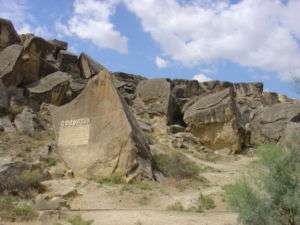
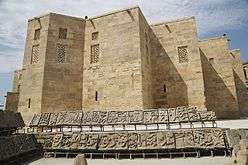 Palace of the Shirvanshahs, Baku (UNESCO World Heritage Site)
Palace of the Shirvanshahs, Baku (UNESCO World Heritage Site) Maiden Tower, Baku (UNESCO World Heritage Site)
Maiden Tower, Baku (UNESCO World Heritage Site) Inner City (UNESCO World Heritage Site)
Inner City (UNESCO World Heritage Site)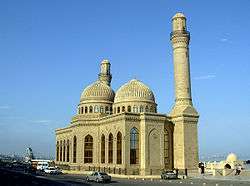 Bibi-Heybat Mosque, Baku
Bibi-Heybat Mosque, Baku- Mardakan Castle, Baku
- Landscape in Quba
- Waterfall in Lerik
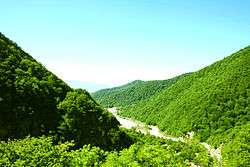 Valley in Ismayilli
Valley in Ismayilli- City tour buses for tourists

.jpg)
See also
References
- 1 2 "CESD Policy Report on Tourism Sector in Azerbaijan" (PDF).
- ↑ https://www.wttc.org/-/media/files/reports/economic-impact-research/2017-documents/global-economic-impact-and-issues-2017.pdf
- ↑ Hope, Katie (19 July 2017). "Where's hot? This summer's most popular holiday spots". Retrieved 24 July 2017 – via www.BBC.com.
- ↑ Holding, APA Information Agency, APA. "Azerbaijan announces rules of e-visa issuance through ASAN Visa system". Retrieved 2017-05-18.
- ↑ "Home Page – The Electronic Visa System of Azerbaijan Republic". www.Evisa.gov.az. Retrieved 24 July 2017.
- ↑ "Home Page – The Electronic Visa System of Azerbaijan Republic". www.Evisa.gov.az. Retrieved 24 July 2017.
- ↑ FS. "Asan visa". mfa.gov.az. Retrieved 2017-11-03.
- ↑ Holding, APA Information Agency, APA. "ASAN xidmət" (in Russian). Retrieved 2018-04-23.
- ↑ "Number of foreign citizens arrived to Azerbaijan by countries".
- ↑ "Статистика в области туризма | Министерство Культуры и Туризма Азербайджанской Республики". Mədəniyyət və Turizm Nazirliyi. Retrieved 2018-04-23.
- ↑ "Туристический бум". dlmn.info (in Russian). Retrieved 2018-04-23.
- ↑ "Азербайджан – Новое Туристическое Направление | Baku Shopping Festival". Baku Shopping Festival (in Russian). Retrieved 2018-04-23.
- ↑ "Azərbaycanda turizm". www.azerbaijans.com (in Azerbaijani). Retrieved 2018-04-23.
- ↑ "В Азербайджане создается "Халяль-туризм" – To Baku". tobaku.ru (in Russian). Retrieved 2018-04-23.
- ↑ "Азербайджан. Миграция, виза, туризм". polpred.com. Retrieved 2018-04-23.
- ↑ CBC.AZ. "В Азербайджане развивается гастрономический туризм". CBC.AZ. Retrieved 2018-04-23.
- 1 2 "Отдых в Азербайджане 2018". www.turizm.ru (in Russian). Retrieved 2018-04-23.
- ↑ "Гянджа, курорт". www.alean.ru (in Russian). Retrieved 2018-04-23.
- ↑ "Отдых в Шеки". ruspo.ru. Retrieved 2018-04-23.
- ↑ Ашурбейли Сара. История города Баку: период средневековья. Баку, Азернешр, 1992; page 149
- ↑ "Archived copy". Archived from the original on 28 April 2010. Retrieved 2009-05-07.
- 1 2 Marshall Cavendish (2007), Peoples of Western Asia, Marshall Cavendish Corporation, ISBN 0-7614-7677-6,
... Oil oozes up out of the ground in the region of the Apsheron ... natural oil fires were revered long ago by Zoroastrians, to whom fire is a sacred symbol ...
- ↑ Ervad Shams-Ul-Ulama Dr. Sir Jivanji Jamshedji Modi, Translated by Soli Dastur (1926), My Travels Outside Bombay: Iran, Azerbaijan, Baku,
... 'maybe, that before Moslem epoch it was Zoroastrian Fire Temple, which was destroyed by Arabs and later was restored by Hindu people for their purposes' ... Farroukh Isfandzadeh ... Not just me but any Parsee who is a little familiar with our Hindu brethren's religion, their temples and their customs, after examining this building with its inscriptions, architecture, etc., would conclude that this is not a Parsee Atash Kadeh but is a Hindu Temple ... informed me that some 40 years ago, the Russian Czar, Alexander III, visited this place with a desire to witness the Hindu Brahmin Fire ritual ... gathered a few Brahmins still living here and they performed the fire ritual in this room in front of the Czar ... I asked for a tall ladder and with trepidation I climbed to the top of the building and examined the foundation stone which was inscribed in the Nagrik [or Nagari] script ... the installation date is mentioned as the Hindu Vikramaajeet calendar year 1866 (equivalent to 1810 A. D.) ...
- ↑ Centre, UNESCO World Heritage. "Gobustan Rock Art Cultural Landscape". whc.UNESCO.org. Retrieved 24 July 2017.
- ↑ "www.ecotourism.aznet.org/naturalobjects/gobustan.html – Сервис регистрации доменов и хостинга *.RU-TLD.RU". www.Ecotourism.Aznet.org. Retrieved 24 July 2017.
- ↑ David C. King. Azerbaijan, Marshall Cavendish, 2006, p. 99
- ↑ "Heydər Əliyev Mərkəzi". www.HeydarAliyevCenter.az. Retrieved 24 July 2017.
- ↑ "Горный туризм". Горный Спортивный Клуб – Азербайджан – Баку. Retrieved 2018-04-23.
- ↑ "Xinaliq – Azerbaijan's highest village". Wordpress.com. 20 May 2014. Retrieved 24 July 2017.
- ↑ "Azerbaijan Travel". Azerbaijan.travel. Archived from the original on 13 July 2017. Retrieved 24 July 2017.
- ↑ "İsmayıllı Rayonu – İsmayıllı". www.Ismayilli.org. Retrieved 24 July 2017.
- ↑ Sakellaraki, Ioanna. "A Journey Around Quba's Mountain Villages in Azerbaijan". TheCultureTrip.com. Retrieved 24 July 2017.
- ↑ "Azerbaijan Travel". Azerbaijan.travel. Retrieved 24 July 2017.
- ↑ "Shahdag Mountain Resort". shahdag.az. Retrieved 24 July 2017.
- ↑ "Tufandag Yay Qis istirahet kompleksi". Tufandag.az. Retrieved 24 July 2017.
- ↑ "Hunting season opens in Azerbaijan". Azernews.az. 3 June 2015. Retrieved 24 July 2017.
External links
| Wikivoyage has a travel guide for Azerbaijan. |
| Wikimedia Commons has media related to Tourism in Azerbaijan. |

